SPLINTERS
Tennessee Valley Woodworkers
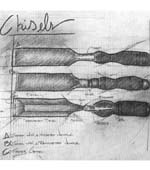 Vol. 18/ Issue 7 July
2003 Editor: Tom Gillard Jr.
Vol. 18/ Issue 7 July
2003 Editor: Tom Gillard Jr. 

Meeting Notice:
The next meeting of the TN Valley Woodworkers
Will be held, July 15th, at 7:00 p.m. in the
Duck River Electric Building, Dechard, TN
All interested woodworkers are invited!

The following people have agreed to serve as contacts for their particular
skills. If you have questions, suggestions for activities, or other
comments relating to these skills, please call these folks. Their
interest is to help the club better serve their area of expertise.
Your participation with them will help them achieve that goal.
Design: Alice
Berry
454-3815
Finishing: Phil
Bishop
967-4626
Turning: Tom
Church
967-4460
Carving: Harry
May 962-0215
Sharpening:
Bob
Reese
728-7974
Joinery: Ross
Roepke 455-9140
Health and Safety:
Maurice
Ryan 962-1555
List of
Club Officers
President: Doyle
McConnell
V. President: Ken
Gould
Secretary: Barbara
Keen
Treasurer: Henry
Davis
Publicity: Loyd
Ackerman
Newsletter Editor Tom Gillard
Jr.
GOD BLESS AMERICA!

Please remember, in your thoughts and prayers, all our Troops heading
for the Middle East.
FOR MEMBERS ONLY
Don't forget about the club give-away this year.
We have a Tormek sharpening machine for some lucky winner at the Christmas
party.
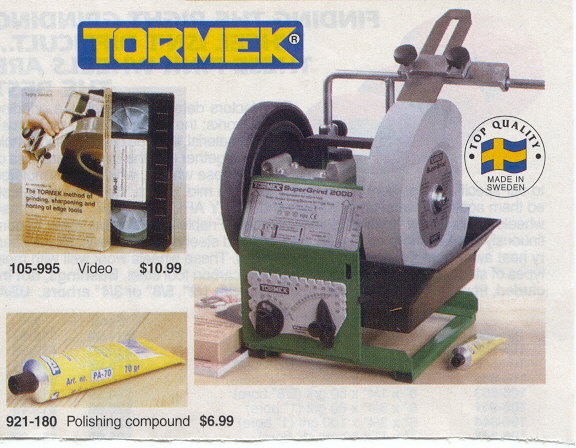
New Business:
The Fall Seminar, “Laws of Woodturning” has been scheduled for October
25, 2003. Subject matter offered will be both basic and intermediate
from the artistic and practical application. Also, included will
be the importance of determining the speed of the lathe. Loyd’s example
of the “exploding bowl” emphasizes the need for correct speed. The
location of the class and more details of the seminar will be forthcoming.
Jim Van Cleave announced
that he would be teaching others the art of making cockbead sometime the
last of July or the first of August. A sign-up sheet was provided
to determine interest and possible dates.
Andy Weaver announced
that there is a festival, “Great Outdoor Week-end on the Mountain”
being planned for October 17,18 & 19 in the Gruetli Park. Members
are invited to participate with demonstrations and sale of craft items.
See him for further details.
There was a good story on NPR the other day. Click here
for the link. Maybe we should try this again. I know we
use to do this many years ago...
Greenheart
Duck! Here Comes the Greenheart
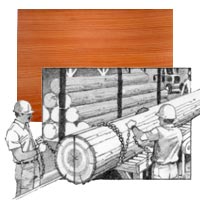
Explosive as well as poisonous, greenheart does have some good qualities–like
durability that rivals teak’s.
Sawyers in Guyana, Surinam, and Venezuela have nasty enough work in
the tropical
heat day in and day out without worrying about exploding logs on top
of it all. But
when a load of greenheart comes to the mill, they treat the logs like
a truckload of
ticking time bombs.
The species Ocotea rodiei, it seems, has an usual tendency to split
apart so quickly
and with such force that pieces of the log can fly when air hits the
saw kerf. In at least
one instance, sections of a greenheart log actually pierced a mill
roof. To prevent
such mishaps, mill hands secure the section of the log that has already
passed
through the saw with a stout chain.
As if controlling greenheart’s explosive tendency isn’t a scary
enough situation, all who work the wood also must avoid
getting splinters. That’s because greenheart, while nontoxic
and nonirritating to the touch, somehow causes severe
infection when splinters of it penetrate the skin.
"Why do these lumberman even bother with the wood?" For several
reasons. Besides being a pretty wood, greenheart
ranks second only to teak in its natural resistance to marine
borers and other insects attacks.
It also has high shock resistance, great crushing strength, a
high density, and takes a polish with little effort. Such
attributes attract ship and boat builders. Before man-made materials,
fishing rod makers liked greenheart because it
bent without breaking.
Illustration: Jim Stevenson.

Show & Tell:
Loyd Ackerman showed a walnut
vessel turned on center noting that the pith had been removed to prevent
cracking. The excellent finish was 3 coats sanding sealer and 6 coats
of Deft. He also showed a purple heart
bowl with a burnt edge. The edge was made by holding cardboard
against the vessel surface, while the bowl was turning on the lathe.
Hugh Hurst showed a beautiful Mesquite
natural edge bowl. He noted that the Texas wood cuts as if it
were butter. He also is in the process of making a cannonball bed
and showed the practice posts that
he had turned. Often, the practice turnings can eliminate
the errors that may occur in turning.
Bob Leonard brought his version of the “wedgie”
along with the article in a recent publication about the virtues of using
this when planting.
Doug Dunlap brought a plant stand constructed with
the use of splines of plywood. The beautiful stand was constructed
of cherry and walnut with a boiled
linseed oil finish. He expressed appreciation to Henry Davis for the seminar
recently held.
Bill Davis brought a maple
plant stand, finished with 3 coats of Deft.
Bill Duncan showed a plant
stand top. The top was finished with 3 coats of tung oil, applied by
pouring the oil on the surface and rubbing with the heel of his hand.
Ross Roepke gave hints concerning glue-up processes
on multiple part assemblies. He also showed push sticks made for the table
saw to cut small pieces safely.
Bob Reese brought a
violin, which was his 15th. His wife played it beautifully.
This instrument had a visible glue joint on the back, which had been cleverly
disguised with an artist painting. Also, his hand-powered
car for his great grandchild was intriguing to all the “little boys”.
The walnut music stand with adjustable positions was beautiful.

Helpful hold-downs
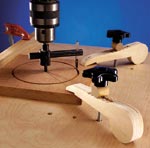
Keep your fingers safe and your workpiece steady with a few pieces
of wood and the turn of a T-nut.
For drilling jobs, it’s essential that you hold the workpiece securely
to the table and against a
fence before engaging the bit. With smaller workpieces you may not
have clamps with the
necessary jaw depth, and, as shown in the example left, you don’t want
to get your fingers
close to knuckle-busting circle cutters. Hold-downs are the answer,
and here’s a version that
will only set you back the cost of the knobs and all-thread rod. (Many
woodworking catalogs
carry such knobs.) Use the full-size pattern and drawing, below, to
make a hold-down.
We drilled three holes into each side of our drill-press table
for accommodating workpieces of various sizes. Each hole
is outfitted with a T-nut for accepting the 1/4" all-thread rod.
(WOOD-Online)
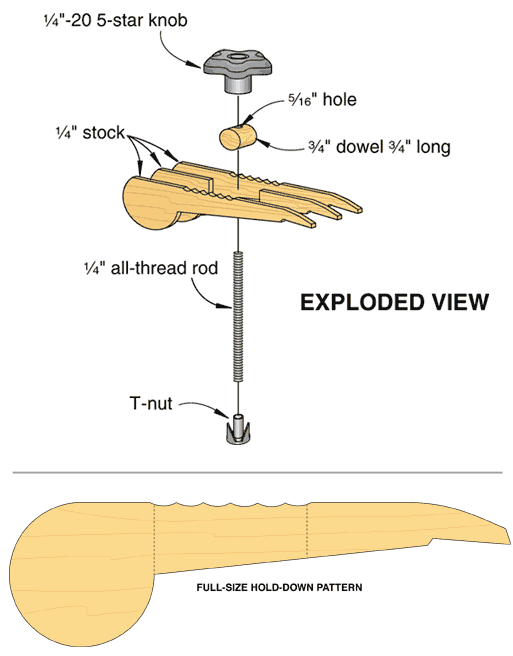
June Program
Ken Gould introduced our guest, Howard
Rust, Jr, of Northside Clocks who presented an interesting and informative
program regarding the history of clock making, noting that the art originated
in China in 1365 and was first practiced in this country in 1750.
The first clock maker, Eli Terry paid the fees for Seth Thomas and another
gentleman to come to this country. They were indentured to him for
a period of 10 years. Only 3 clocks were made each year. The internal
works were wood with the use of quarter-sawn oak as front and back
plates and apple for all the gears. The apple wood is extremely hard,
holding up well through much use. The internal works of a clock of
this period evidenced this. Each member had the opportunity to examine
this.

FREE Woodworking Charts
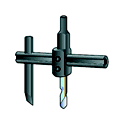
If you're like most woodworkers,
you have at one time or another
ruined an expensive drill bit or
cutter by running it at too high a
speed in your drill press. So how
do you go about finding out the
recommended operating speed
for any given tool so this doesn't
happen? Up until now, it's been almost impossible!
DOWNLOAD CHART HERE
September 22 thru 27 --
Coffee County Fair. TVWW has a building in the Morton Village section
of the fairgrounds. Morton Village is behind the livestock barn and
the main arena area. We will be exhibiting and demonstrating there
during the week but will have a concentrated effort on Friday and Saturday
(26,27th).
FOR SALE
Wood for Sale:
Contact Ross Roepke regarding
2000 board feet of cherry and 1000 board feet of walnut.
Sears: 6 x 48" belt / 9" dia disk sander
Comes with a few extra disks It has the stand to go with it.
Click
here to view some pictures of the sander
Contact: Tom Gillard Jr.
455-6651(H), 393-0525(W)
$125.00
*** Beginning with the July 22 2003 meeting the Stones River Woodworkers
Club will meet at the Farm Bureau Insurance Building, 818 S. Church
Street (Highway 231) Murfreesboro,TN at 7:00 PM.

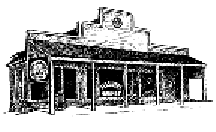

10 % OFF Fine Woodworking
Books from Taunton Press
…We’re open Monday thru Saturday
SEE YOU ON THE
15th!
 Vol. 18/ Issue 7 July
2003 Editor: Tom Gillard Jr.
Vol. 18/ Issue 7 July
2003 Editor: Tom Gillard Jr. 






